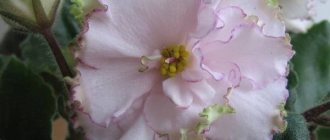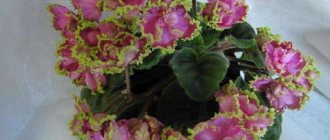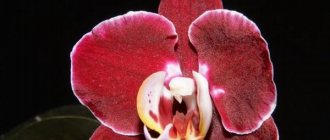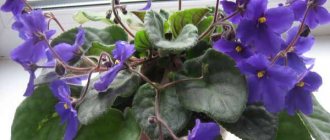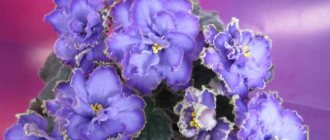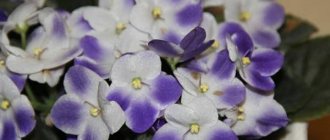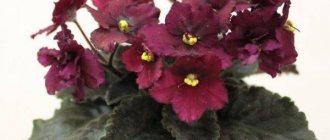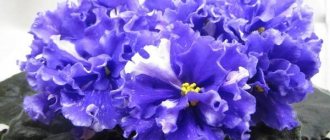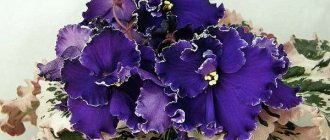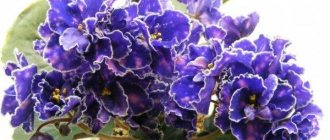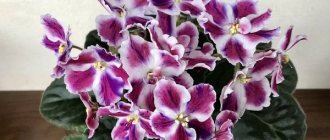Violet is one of the most common house plants. The diversity of their appearance and long flowering leaves no one indifferent.
There are more than 30 thousand registered varieties of violets alone , this indicates their popularity and ease of care.
The violet varieties PT-Yanina and PT-Dancing Geisha (T. Pugacheva) are no exception; they are unique and loved.
Violet PT-Ioannina
Evergreen herbaceous perennial, low growing.
Thanks to the painstaking work of T. Pugacheva, this gorgeous plant was obtained.
Genus, family
The violet variety PT-Yanina belongs to the Gesneriev family.
Genus: Saintpaulia violet. Indoor violet, the ancestors of which were grown in 1893.
The discoverer of violets was Baron Walter Saint-Paul, who served at that time (1892) as a military commandant in the Uzambara district. The first artificially grown plant was named after the Saint-Paul genus (Saintpaulia).
Origin story
The creator of the Yanina variety is breeder Tatyana Pugacheva from Kursk , Russia. The variety was released in 2014.
Attention! The initial letters before the name of the variety usually indicate the initials of the author of the variety. In this case – PT.
Photo and description
Features of violet PT-Ioannina:
- the socket is smooth, neat, exhibition;
- leaves are simple, dark green;
- the outer petals of the flower are greenish, and they remain that way until the end of flowering;
- Ioannina violet flower is pale pink, large (5 - 7.5 cm), semi-double;
- A lilac-pink border adorns the edges of the delicate petals. Usually the border appears only during the second flowering;
- during the entire flowering period, the flowers do not fade or even turn pale;
- Flowering is bouquet and long.
Blooms elegantly. Look at this photo of the PT-Ioannina violet, the border on the petals is clearly visible here. No two colors are the same.
Variegation, imprints
The PT-Ioannina variety is not a variegated variety. The leaf plates in the rosette have a uniform color.
Sports
Flower growers use the word “sport” to refer to the children of the Uzambara violet that have not inherited the genes of the mother plant. This happens, but the phenomenon does not mean that a new variety has been obtained; this phenomenon is considered a defect . Even if the resulting plant is many times more beautiful than its parent.
Features of flowering, growth and reproduction
Much in the behavior of violets is determined by the nuances of care. Some petals darken very early, while others do not have a border at the tips.
It is necessary to realize that the environment has a significant influence on varietal characteristics.
The growth and reproduction of this variety is no different from most varieties.
When rooting stepsons, you need to remember that the plant needs a special microclimate , so to create it you should put a thin plastic bag on the pot.
Development at home
The plant will respond well to good care. You can safely hope for a positive review from this variety, observing the following conditions:
- temperature range within 18 – 23°C;
- the duration of daylight is at least 12 hours a day;
- correct and timely watering and replanting.
How long does it take to grow an adult plant?
It is possible to obtain an adult plant of the PT-Yanina variety only vegetatively.
The fastest way is to root the stepson (if any) in sphagnum.
Moss retains moisture well and has strong antibacterial properties.
Sold in flower shops.
How are varietal characteristics transmitted?
The Ioannina variety is propagated by leaves, but it is recommended to cut the cutting shorter , or even leave only the leaf blade.
Violet children generally retain the varietal characteristics of the parent . To find out if this is true, you need to wait for flowering.
Flowering in hot and cool conditions
Like all Saintpaulias, Ioannina does not like direct sunlight . They discolor flower petals.
Heat greatly affects the duration and quality of flowering, and not for the better. Lowering the temperature will help correct the situation.
What do flower stalks look like?
Ioannina’s flower stalks cannot be called too short. Medium length, strong and erect. They present pink flowers as a jewel and it looks very advantageous.
PT-Ioannina has quite long flower stalks.
Is it possible to achieve cap flowering?
Very patient people can try. For several months after transplanting into an adult pot, it is necessary to pinch off all emerging buds . All! Angry Janina will react with a bouquet of flowers.
Reviews
Mayorova Irina. Kyiv. “In the first flowering there were very few flowers, or rather there was only one. But what a one! I'm looking forward to the next bloom."
Antonina Sivokon. Mogilev. “I fell in love with the variety at first sight and, I must say, mutually. The variety is flexible, blooms beautifully and for a long time. No complaints yet.”
Course of life stages
The simplification of most measures for caring for the variety occurs to a large extent due to the correspondence of the phases of its life processes along time boundaries with the standard development periods of many beauties of the genus. Based on this coincidence, growers can create treatment schedules based on the classic model and adjust them in accordance with the nuances of the variety.
Specificity of development in indoor collections
The varietal violet, when growing from a young child and further developing as an adult plant, manifests itself as a disciplined specimen for the home collection:
- Does not bother the grower with unnecessary problems;
- Does not pick and choose regarding agricultural technology regimes;
- And content parameters.
IMPORTANT! It pleases with constant and exquisite flowering with standard care.
Among the positive characteristics of violets, one can highlight such important features as:
- Ability to design a harmonious silhouette of a leaf rosette;
- Excellent display of resilience and resistance to negative consequences in case of minor violations of maintenance regimes;
- Simple propagation techniques and good preservation of the quality of the variety;
- Lush flowering of the cap type with a long stage of preserving the decorativeness of the corollas;
- Formation of a dense texture of peduncles;
- Large sizes with a lush texture at the corollas.
The presence of a lot of qualities favorable for indoor plants does not prevent the violet from having several negative features :
- Some dependence of color on the temperature gradient;
- Gradual increase in maximum indicators of flower varietal characteristics;
- Long growth rates and slow set of adult characteristics of bushes;
- The need to organize forced rest by removing peduncles in order to prevent the violet from weakening as a result of the constant formation of buds;
- Deviation of leaf plates from an even position in the rosette due to their waviness.
Features of reproduction
There are only two vegetative methods for young violets:
- Children from leaf cuttings;
- Stepchildren from the mother plant.
Experts do not recommend propagating violets by seeds.
Feedback on warmth in flowers
The variety responds to temperature gradients by changing color, and its flowers and buds completely fall off during sudden changes in heat and drafts!
Pedicel strength
Violet flower stalks:
- They have a strong texture;
- And they easily support heavy flowers in an upright position.
Flowering type
Violet is quickly able to form voluminous caps , increasing in size with each subsequent wave of flowering.
Violet has unusually lush flowering.
Flower lifespan
Each corolla can maintain a fresh appearance for more than a month .
Violet PT-Dancing Geisha
An unusually beautiful variety.
Large, with elaborate frills, bewitchingly beautiful flowers.
Genus, family
PT-Dancing Geisha belongs to the Saintpaulia genus, Gesneriaceae family.
Origin story
The famous Kursk violet breeder Tatyana Pugacheva created her next masterpiece in 2018 . The variety quickly gained popularity.
Features of the variety
Below you will find a photo and description of the violet PT-Dancing Geisha:
- the flowers are very large . The white wavy-corrugated border goes well with the main light crimson color of the flowers. The petals are very showy, the center is white. The flounces look stunning!
- the rosette is medium in height, medium-sized, leaf color is green with an olive tint;
- flowering is lush, abundant, long lasting.
Variegation, imprints
These qualities are varietal characteristics. Variety PT-Dancing Geisha, non-variegated.
Sports
Sport is a violet that blooms out of sorts. During the process of mutation, the offspring of a given variety may have a different color or have leaves of a different shape. An adult plant cannot be propagated. And it is impossible to derive a variety from it.
To protect yourself from the appearance of sports, you need to root the leaf without a cutting, from the leaf plate.
Features of flowering, growth and reproduction
If you follow all the rules for caring for this variety, the flowering is long and bright.
The intensity of flowering depends on the temperature in the room where the plant is located.
Development at home
PT-Dancing Geisha is a non-capricious variety and does not require special care.
However, you should follow some simple rules:
- water into the edge of the pot or through a tray;
- they do not like bright direct sun;
- in the shade the leaves may lighten and the petioles will stretch out.
How long does it take to grow an adult plant?
The fastest way to get an adult plant is only from the stepsons on the mother bush. They are cut off and rooted.
Propagation by cuttings takes longer.
How are varietal characteristics transmitted?
In vegetative propagation, a daughter organism is obtained from the parent material. The rudiments of a new plant are formed at the site of the cut, and this is how the regeneration process begins.
Flowering in hot and cool conditions
In the hot summer, the color of the flowers may fade. With the onset of cooler temperatures, the color is restored.
What do flower stalks look like?
The PT-Dancing Geisha variety has short peduncles. Heavy large flowers lie beautifully on a green rosette.
The peduncles of PT-Dancing Geisha are short and strong.
Is it possible to achieve cap flowering?
Violets will reward you with cap blooms if:
- The transplant was made on time. It is better to carry it out with complete rejuvenation;
- after transplantation, you cannot fertilize (the soil is fresh);
- length of daylight hours 12-13 hours;
- temperature within 20-23° C;
- The buds are removed for at least 3 months.
It's not difficult, but it's worth a try!
Flowering duration
Typically flowering lasts from 6 to 10 months a year. After this comes a rest period, which averages two months.
The break occurs during the hottest summer time. But this can be corrected by creating an appropriate microclimate.
Some gardeners claim that with ideal care, flowering can continue all year round. However, such continuous flowering greatly exhausts the plant.
Reviews
Marina Antokhina. Moscow region. “The flowers are very beautiful, but I had to form the rosette myself.”
Yulia Morozova. Crimea. “The dancing geisha is truly, as described, excellent! I recommend to everyone. I’ll especially note the color of the petals, awesome!”
Violet Jolly Mel – variety description
Variegated heart-shaped leaves are collected in a small rosette. The leaves are different:
- Accuracy;
- And miniature.
Advice! Periodic unfolding of the violet prevents the possibility of uneven development of Saintpaulia.
Mysterious violet Jolly Mel.
Even without flowering, Mel has a very impressive appearance.
An attempt to convey color. The photo taken in natural daylight is shown above.
Semi-double or simple pansies . A cap of bright, richly colored flowers looks very advantageous framed by unusual leaves. Flowers are literally born, and for this he is reputed to be slow-witted.
I would like the flower stalks to be a little longer. Flowering is almost constant.
Sports varieties Jolly Mel
The sport has more pinkish flowers.
Similar to Jolly Jubilee, but Mel's flowers have a more reddish tint .
Features of Jolly Mel content
Reproduces vegetatively. Does not make any special .
Saintpaulia reproduces well vegetatively.
To ensure regular and abundant flowering, a microclimate is necessary that will promote the development of the plant.
Good lighting is the key to the beauty of Jolly Mel . Recommended daylight hours for the variety are 10 or 12 hours.
The color saturation of flowers can be influenced by :
- Substrate composition;
- Or the room temperature.
The leaf plate reacts to a decrease in temperature - it becomes brighter , more white color appears.
The plant is not as fragile and capricious as it seems at first glance.
You should not be afraid to add this miracle to your collection.
The photo on the left shows the unusual Saintpaulia Jolly Mel.
Jolly Mel reviews
Kondratyuk I. P. Irkutsk region. “Pittman once again pleased us with a wonderful variety. The miniature blooms beautifully.”
S. Ryzhenko Kyiv. “There were problems with flowering; the buds were hidden under the leaves and even bloomed there. Although they don’t complain about the variety. I wasn’t very lucky, I just got caught by a lazy person.”
Rules for caring for Saintpaulias at home
If care were difficult, violets would not be so popular. Like all indoor plants, violets have their own care rules.
Conditions of detention
Violets really don't like large pots . A pot whose diameter is 3 times smaller than the diameter of the rosette is considered ideal.
A guide to determining the optimal pot size.
Attention! The transplanted violet will not bloom until the entire earthen ball is entwined with roots.
Proper watering and fertilizing
When choosing an irrigation mode, the orientation is to the top layer of soil:
- dry - water;
- wet - do not water.
Stagnation of moisture in a pot with a plant leads to the appearance of various kinds of insects in it. As a result of their vital activity, the substrate becomes unusable, which negatively affects the root system and the plant.
Fertilizing is carried out only as needed, this happens during the period of intensive growth of leaves. Fertilizer is applied along with watering.
Lighting and temperature
The violet needs light, but not bright and direct, but diffused.
All windows are suitable
The duration of daylight hours ranges from 12 to 14 hours a day.
Air humidity
Dry air affects flowering. It would be more correct to say that at low humidity the violet will not bloom.
What kind of soil does he prefer?
Experienced collectors and flower growers claim that there is no specific and especially ideal verified recipe for making a soil mixture for violets. In each region, the components sold are quite different, and the composition of the soil always depends on the size of the collection and even on the financial situation.
Another thing is that the basic principles of compiling soil mixtures for violets are always the same. The soil mixture should be:
- breathable;
- moisture-absorbing;
- low-fat;
- loose;
- easy.
There are many recipes for preparing soil mixtures. By exchanging one component for another, the most suitable composition is selected. Many people successfully use store-bought ready-made substrates.
In stores you can find various ready-made soils for violets.
Attention! The soil mixture for violets is not reused!
Pruning and hygiene
Adult violets need timely pruning of old leaves.
to remove faded flowers and peduncles as they appear . After all, they are no longer aesthetically pleasing; a new wave of flowering is being stimulated.
Washing dusty leaves is necessary. After the procedure, you need to let the flower dry in the shade.
Reproduction methods
Three possible methods of reproduction:
- leaf;
- baby;
- seeds.
Violets are mainly propagated vegetatively . Growing plants from stepsons is the fastest way.
Stepsons.
If the violet has released a miniature plant from the leaf axil, it is grown, cut off and rooted. It is most convenient to do this in small plastic containers using sphagnum moss.
Thus, in a fairly short period, an adult plant is obtained that has retained all its maternal forms. The whole process takes 3-4 weeks.
There is another way to obtain a new plant - from a leaf cut from the mother specimen and planted in a glass.
For propagation, take any leaf from the rosette in the top or middle row . The cut is made oblique and dried or sprinkled with crushed activated carbon. The resulting cutting is placed in water for rooting.
The water is changed once every 7 days. Roots appear within a month. Next, we plant it in the soil mixture and wrap it in a plastic bag.
The result of the work is a plant grown independently. This method is longer and will take 2-3 months.
Transplant rules, rejuvenation
It is recommended to replant violets as they grow. Adult plants - every six months. Children are transferred more often, after 2 or 3 months.
The best time is autumn or spring.
Attention! Transplantation during budding or flowering can be carried out only if absolutely necessary.
Useful tips
Some useful tips for choosing violets:
- Would you like to purchase a certain type of violet? Buy only a flowering plant;
- Choose not a leaf for propagation, but a stepson (if you have a choice);
- Do not take a violet with spots on the leaves, this may be a sign that the plant is going into sport;
- It is best to root cuttings in sphagnum (the leaf petiole rots in water);
- To enhance flowering, you need to remove the stepsons and increase the length of daylight hours by 2 hours.
